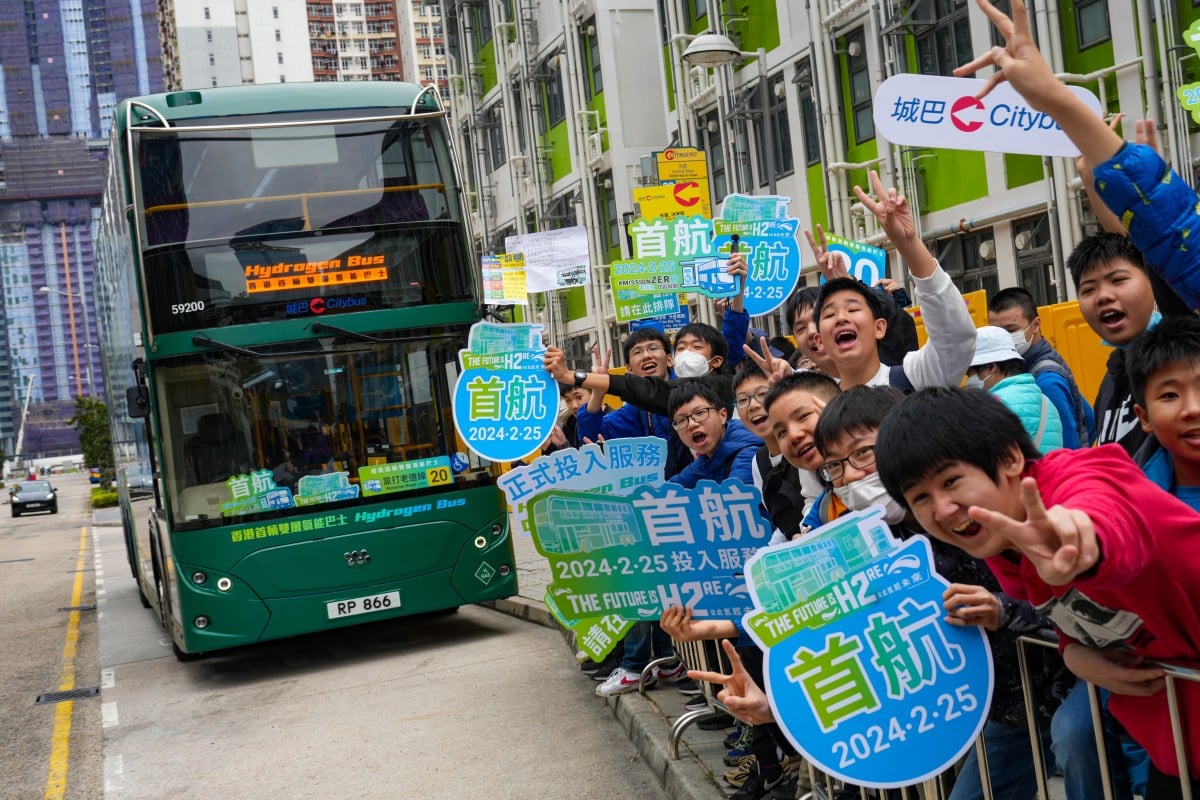
- Eco-friendly vehicle will run on ‘Waterloo Road Line’ – route 20 travelling through Kowloon City, Yau Tsim Mong and Sham Shui Po
- Understand why this technology is more environmentally friendly than their diesel-fuelled counterparts
 Dozens of bus fanatics, with some queueing hours in anticipation, cheer on board the maiden voyage of Hong Kong’s first hydrogen-powered double-deck bus. Photo: Sam Tsang
Dozens of bus fanatics, with some queueing hours in anticipation, cheer on board the maiden voyage of Hong Kong’s first hydrogen-powered double-deck bus. Photo: Sam TsangHundreds of bus fans queued to board Hong Kong’s first hydrogen-powered double-decker bus that went into service last month. Citybus said this was the first vehicle of what would be a zero-emission fleet by 2045.
Enthusiasts started to line up as early as 3am on Muk On Street in Kai Tak on February 25 to watch the HK$8 million bus enter into service at 11am. More than a hundred people, equipped with cameras and placards, secured places for the first run along route 20, which goes through Kowloon City, Yau Tsim Mong and Sham Shui Po.
Ken Lai, 18, was the first in the queue to board the bus in Kai Tak with friend Daniel Cheng, 14. “I started lining up at 3am this morning, and I brought along some snacks to eat while waiting,” Lai said.
“I am most excited for the bus to stop by the Yau Ma Tei Wholesale Fruit Market, a historical place, to juxtapose with the new technology of this bus.” The two dashed up to the top deck when the bus doors opened and managed to grab a coveted front row seat, which Lai said offered the best view.
Gordon Auyeung, 12, said he started to queue at about 9am and managed to get a seat next to the hydrogen battery-powered bus engine on the lower deck.
Combat climate change and reduce your carbon footprint by cutting down on beef
“I look forward to the moment when the bus accelerates, to feel the difference between the hydrogen-powered bus and a petrol-fuelled one,” he said. “The engine on this bus is much quieter, and it also doesn’t emit air pollutants.”
Some bus enthusiasts filmed the entire route from the front of the top deck, and others recorded its bell, announcements and the engine noise. Others who were unable to board the bus, which has a capacity of 119, instead staked out spots along the route to catch a glimpse of the vehicle as it passed.
Roger Ma Chim-wai, the general manager of operations for Citybus, said the new bus would make six to eight trips a day on route 20 in its first month. He added the bus would move to route 22M between To Kwa Wan and the Kai Tak Cruise Terminal and route 20A, which brings passengers from the Kai Tak Cruise Terminal to the West Kowloon High Speed Rail Station, after that.
“We hope to deploy the hydrogen buses to serve on the Hong Kong Island side, but our existing hydrogen refill station is located in Kowloon,” Ma said. “One of the limitations in the regulations is that hydrogen buses cannot travel in tunnels.”
Citybus said refuelling took about 10 minutes and allowed the bus to travel up to 400km. The company said its 2045 target for a zero emissions fleet was five years before the government deadline for a carbon-neutral city.
Staff writers
Why is Citybus eyeing hydrogen-powered vehicles?
The buses, fitted with hydrogen cylinders and supply systems, are more environmentally friendly than diesel-fuelled vehicles. This is because hydrogen is turned into electricity through a chemical reaction, and the only emissions are water and warm air.
On the other hand, emissions from petrol and diesel vehicles – such as nitrogen oxides, hydrocarbons, and particulate matter – are a major source of air pollution.
Hydrogen fuel cells are more efficient than many other energy sources. For example, a regular power plant that burns fuel can only turn 33 to 35 per cent of it into electricity, while a hydrogen fuel cell has up to 65 per cent efficiency.
Unlike electric vehicles that need 30 minutes to several hours to charge, small vehicles with hydrogen fuel cells can be refuelled in under five minutes.
SOTY 2022/23: Best Devotion to School winner is a passionate environmentalist
However, hydrogen fuel cells use expensive metals like platinum and iridium, which makes them costly to build. This high cost has discouraged companies from using this technology.
Hydrogen is also a highly flammable fuel source, and strict safety protocols must be implemented during construction.